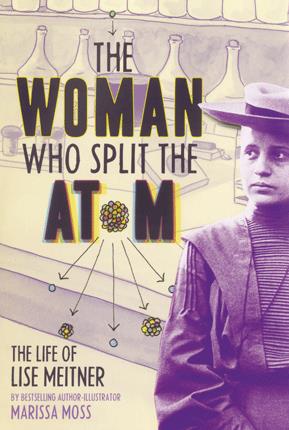| Woman who split the atom : Lise Meitner Author: Moss, Marissa | ||
| Price: $24.48 | ||
Summary:
As a female Jewish physicist in Berlin during the early 20th century, Lise Meitner had to fight for an education, a job, and equal treatment in her field. She made groundbreaking strides in the study of radiation, but when Hitler came to power in Germany, she suddenly had to face not only sexism, but also life-threatening anti-Semitism. After she discovered the splitting of the atom, a male colleague won the Nobel Prize for her work and the race to build the atom bomb began, much to her horror.
Reviews:
Kirkus Reviews (+) (02/01/22)
School Library Journal (04/01/22)
Booklist (+) (02/15/22)
The Bulletin of the Center for Children's Books (00/04/22)
The Hornbook (00/07/22)
Full Text Reviews:
Booklist - 02/15/2022 *Starred Review* Lise Meitner, a young Jewish Austrian woman with a doctorate in physics, moved to Berlin in 1907 in hopes of doing significant work, but she was disappointed that the university lagged in accepting women as equals. Still, her radium research with chemist Otto Hahn yielded discoveries including a radioactive element. Reluctant to leave Germany despite growing Nazi persecution, Meitner escaped to Sweden in 1938. Later that year, when Hahn wrote asking for help interpreting an inexplicable result in an experiment related to their research, she realized the anomaly’s significance, explained it to him, and coined the term nuclear fission. Hahn received the Nobel Prize for nuclear fission but failed to credit Meitner for her work or her pivotal insight. She was dismayed when nuclear fission led to the atomic bomb. Moss’ approach to this biography is notable in several ways, from the organization of facts into a very readable narrative to surprisingly clear explanations of Meitner’s scientific work and its significance. Even the back matter is uncommonly useful. Each chapter opens with a single graphic-novel-style page that conveys background information to readers while setting the scenes, depicting key individuals, and moving the story forward dramatically. Pair this book with Jeannine Atkins’ Hidden Powers (2022), a biographical novel in verse, for a complementary approach to Meitner’s compelling story. - Copyright 2022 Booklist.
Booklist - 02/15/2022 . - Copyright 2022 Booklist.
School Library Journal - 04/01/2022 Gr 4 Up—The story of a brilliant physicist's life intertwined with Nazi Germany and the development of the nuclear bomb. Lise Meitner loved physics, and her discoveries were some of the most respected and celebrated in the 20th century. Her story of discovering nuclear fission develops as Nazi Germany comes to power and invades Europe. Lise, a Jew, must escape Germany and leave her lab behind. Eventually, other scientists and governments use her discovery to build the first nuclear bomb, devastating her. The book recounts how German scientists also sought to build a bomb, which would have changed the outcome of WWII. The book concludes with Meitner's later years and her long overdue recognition by the scientific community. One-page comic drawings introduce each chapter and bring further life to the story. Moss presents a spectacular story of history, science, and women's struggle for respect through the narrative of Meitner's life. The writing style is captivating and the book is a quick page-turner. A time line, glossary of physics terms, scientist profiles, bibliography, and index enhance the story and point students to further learning. VERDICT An excellent biography that is a first purchase and deserves a place on every nonfiction book list for children.—Kate Rao - Copyright 2022 Publishers Weekly, Library Journal and/or School Library Journal used with permission.





